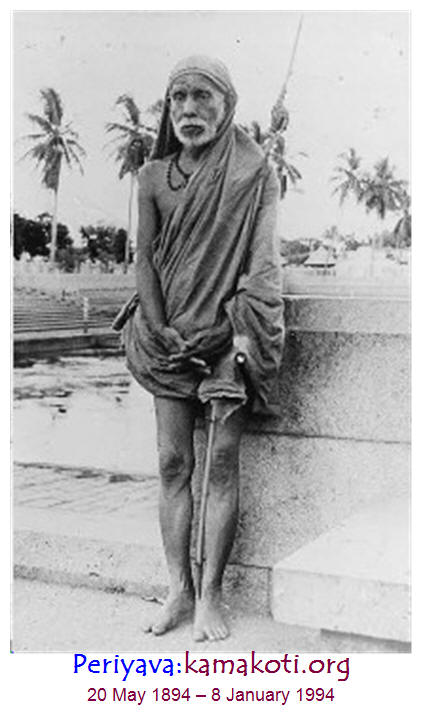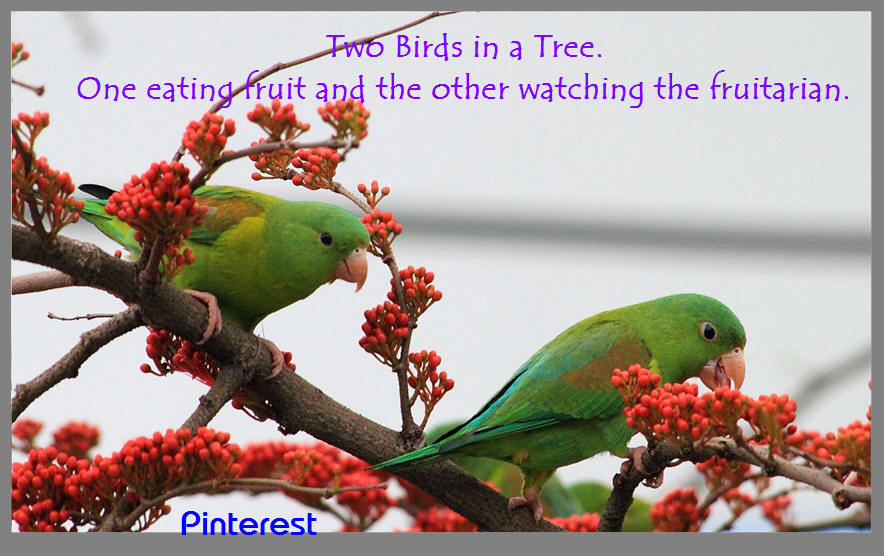(Hinduism The
Putative Religion)
By Periyava
Translation by V.
Krishnaraj
http://www.kamakoti.org/tamil/part1kural29.htm
உலகம் பரவிய மதம் : தெய்வத்தின் குரல் (முதல் பகுதி)
WorldwideReligion: Deivathin Kural (Part one)
 What
we call now as the Hindu Religion – our religion- was the only religion
prevalent all over the world. Because it was the only religion in the
world, there was no need to give it a name.
In our principal religious
texts, there was no name for our religion: That is my opinion.
What
we call now as the Hindu Religion – our religion- was the only religion
prevalent all over the world. Because it was the only religion in the
world, there was no need to give it a name.
In our principal religious
texts, there was no name for our religion: That is my opinion.
Considering the research material from the excavations, we see plenty of
Vedic religion-associated materials in all foreign countries. A thousand
three hundred years before Christ, evidence of an agreement between two
kings in Egypt was dug up from below the ground. The document says that
the agreement was signed by Mitrā Varuṇa as the witness.
Mitrā Varuṇas are our deities mentioned in our Vedas.
Several places (75%) in Madagascar bear names derived from
Sanskrit. The king’s name Ramses and our Rama bear a connection.
In Mexico, there are objects with Hindu symbolism.
During our Navaratri festival, Mexico holds a festival,
Rāma-Sīta. Piḷḷaiyār idols were
discovered
in the excavations in Mexico. Before Spain took the country over, the
word
Aztecs is an inflection of or a derivative from Sanskrit word ‘Āstika.’
In Peru during Vishū auspicious time, they perform sun worship in the
Sun Temple. They are the Incas. Iṉaṉ means the Sun.
Rama was Iṉakula Thilakaṉ (இனகுல
திலகன்).
I saw a photo book that showed the Australian aborigines dancing naked.
'Native Tribes of Central Australia' by Spencer and Gillen have photos
on pages 128 and 129 depicting Siva’s Dance. Upon further scrutiny, I
saw the Third Eye drawn on the forehead of one dancer.
In Borneo, there was a virgin forest not explored by any human since
Brahma’s creation. The later explorers found a document in Grantha
glyphics showing which Maharaja performed Yagna and where he installed
Bhūpasthambam (sacrificial post). It further states that the Brahmins
received Kaṛpaka Virutsa Thāṉam (gift of Wish tree). They said it was
Yuopa inscription of Mulavarman of Koeti. The British who spoke
derisively of our religion discovered all these artifacts.
Let me tell something amazing and funny. The Sāgars in search of
sacrificial horse went digging into the Nether world. The resulting sea
was named after them: Sāgara. At the end, they found the horse near
Kapila Maharishi Āśramam. Thinking he was the horse thief, they punished
him. By his ferocious sight, he burned them down into ash. This story is
in Ramayana. Let us take America on the other side of us as the Nether
world. The possibility is the name Ćampāraṇya became the modern
California. Beside California, there are Horse Island and Ash Island.
Besides Sagārar and Sāgar, Sahara Desert was once a sea.
The thought comes to me whether Sāgaram became Sahārā.
The researchers tell us, recognizing the Hindu symbols all over the
world, there were mutual exchanges of people, goods, and symbols between
India and other nations. There was one Dharma all over the world, that
of Hindu Dharma. These symbols were the creations of the ancient
peoples.
The researchers seeing Hindu symbols in other countries dating back to
2000 years, advance the theory, that immigrant Hindus changed or
replaced the civilization of the adopted countries.
At the dawn of civilization in those countries, the Vedic symbols
existed there. In later years only, the native civilization and religion
appeared among the aborigines of the countries. In Greece, an ancient
religion with pantheism and temples appeared and Vedic religious symbols
were prevalent then. Before Christ, the Semitic and Hebrew religions in
those countries had similarities with Vedic religion including
Varṇāsrama divisions. In Mexico, the aborigines worshipped Nature gods
and performed many rituals.
Now the old Greek (Hellenic) civilization declined and disappeared from
its peak. Christianity has taken its place. Buddhism spread far and wide
to the middle Asia, South Asia…
Some places had Islam. In the jungle habitats of Africa, there
are still extant the original tribal religions. There are abundant Vedic
symbols in these ancestral religions. Let me present to you some
examples.
In early times, the doctrines and principals are
illustrated with stories for the understanding by the laity. Doctrines
may not be easily understood by them. It deserves a story form. Or it
must be given a ritual sanctity with procedural elements.
Observing religious rites reveals to them the symbolism behind the
Tattvas. All rites and rituals are symbolism. The naysayers say it is
enough to understand the inner meaning and dispense with these rites. I
am not in cahoots with the naysayers. There is Sakti in the special
rites. I am not saying that the puranic stories are explications of
Tattvas only and are not to be trusted as factual occurrences. They were
actual historical facts. Besides being historically accurate, they
portray and explain the Tattvas. The rites, when observed, yields fruits
first and later gives Siddha Sakti with deferred fruits. The rituals
offering greatness have in them the Tattvas.
Over may generations, the inner meaning of the rituals may take leave of
the Tattvas or might entirely be forgotten.
When the new religions lacking any relationship with Vedic religion grew
in these foreign countries, the Vaidik Tattvas changed their form,
shape, and spirit.
You must have heard the story of Adam and Eve in Hebrew religion (Old
Bible). Tree of knowledge was well known. The injunction from Isvara was
not to eat the fruit of the tree. Adam did not eat the fruit. But Eve
ate the fruit. Adam ignoring God’s injunction, ate the fruit thinking
whatever high or low happened to Eve, he was ready to face. That was the
first story in Genesis in the Old Bible.
Among the Upanishadic Tattvas, one took on the form of a story:
When the time and the country changed, confusion reigned supreme, as if
the principal Tattva might go obsolete.
What is said in Upanishads? ‘There were two birds in a Pipal tree (Ficus
religiosa). One bird eats the Pipal fruit. The other does not eat the
fruit but keeps looking at the fruitarian bird. Our body is that tree.
Jīvātmā (self-absorbed fruit eater) thinking of himself eats the fruit
of phenomenal existence and experience (the Epicure). This is one bird.
In the body of fruit-eating bird, Paramātmā lives as another bird. He
does not engage in any activity. He is the constant witness observing
the activities of the Jīva bird. Though the 2nd bird is the
basis for the existence of the fruit-eating bird, he does not eat the
fruit, waives experiencing the enjoyment of eating the fruit and is free
from Karma Phalaṁ (Fruits of Karmic actions).

This Jīvaṉ became the Eve in the Abrahamic religions. Jī becoming Ē is a
grammatical rule. Ja series
sounds become Ya series sounds. This is how Yamuṉā became Jamuṉā;
Yōgīndir, Jōgīnthā. Jīva became Ēve (Ēvā). Ātmā became Ādam. Pipalam
became Apple. Tree of Knowledge is our Bhodi Virutsam (Tree of
Knowledge). Bhōdham means Jñāṉam.
Buddha attained Jñāṉam under the Bhōdhi tree. Before that the
Ficus religiosa (Pipal tree) was called Bhōdhi tree.
Upanishad in distant countries after many years changed, took new forms,
and underwent change in the meaning. The story of Ātma, not susceptible
to sensual experiences, took a turn and the Bible story told that Ātma
(Adam) ate the (forbidden) fruit. That was a change in the story. Though
our Bhōdhi Virutsam (Tree of Knowledge) points to renunciation of
pleasures of motor and sensory organs, the Bible refers to the worldly
pleasures of the organs as the Tree of Knowledge. I am not sure whether
our Veda Religion existed there or not in ancient times. Another
example, I present here will give you the confidence (in what I say) and
it is to say that the original story and tattva undergoing changes at
other times in other countries takes us back to the original. Our
Tiruppāvai and Tiruvempāvai poems, presumably 1100 years old, are not as
old as the Vedas.
Andal and Manickavasakar of these said poems were born much after the
Veda-Itihāsas era. After their time, the Hindu empires were established
abroad. Tamil Nadu Chola kings had spread their empire abroad. More than
the invasion, the spread of commerce was important. Because of the
commerce, the foreign contact grew. Seeing these merchants, they were
attracted to Hindu manners, customs, and civilization, and adopted many
aspects of our religion. Far-East countries were in the forefront in
adopting the Hindu civilization. Countries like Bali became Hindu.
Cambodia, Thailand (Siam), Indochina, and Manila (Philippines) came
within the ambit of Srī Vijaya Sāmrājyam.
In the hoary ancient past, that Veda religion existed everywhere was a
reality. Later, new religions cropped up, offering the second reality.
Then, the new religions faded with the rise of Buddhism, Christianity,
and Islam in the native soil. Still later, there was a rejuvenation of
Hindu Civilization in many countries particularly in Angkor Wat,
Borobudur, and Prambanan (the latter two in Indonesia) with the rise of
Tamil Temples. At this stage only, Tiruppāvai and Tiruvempāvai became
part of the liturgical service.
As evidence, year after year, a big festival takes place in the month of
Mārgazhi with the chanting of these poems.
These two poems bring together Saivam and Vaishnavam. In the
Dolotsavam
festival, Sri Malayappa Swamy, Sridevi and Bhudevi are seated on the
swing and swung to the accompaniment of Veda Parayanam and traditional
music.
Dolotsavam
= Dola + Utsavam = Swing or Cradle + Festival = Festival of Swing.
A participant in the guise of
Siva is part of the festival in Siam or the modern Thailand. They are
not familiar with the Pāvai poems as it existed in their original forms,
at present.
They call the poems Triyambāvai and Tripāvai. The Bible readers are not
familiar with Upanishads, but they know the story of Ātmā and Jīvā (Adam
and Eve). The Thais forgot the recitation of Tiruppāvai and
Tiruvempāvai. But they celebrate in Dhanur month the festival of
Dolotsavam and Siva and call it Triyampāvai-tripāvai.
We see such changes in this historical period. There must be
tremendous changes in the original practices from three to four thousand
years ago in the foreign countries. The symbols of Vedic traditions
declare their survival over several millennia and rear their head.
The prehistoric aborigines harbored our religious symbols. What does it
mean? It is unlikely that invasion or commerce from India took our
religion and civilization to the distant lands.
It is not the spread from here
to there. My opinion is the whole world must have had Vedic religion in
the mist of time. Going forward, the Vedic religion and civilization
underwent gradual and relentless changes to what is now considered the
native original or neo-religion in those countries and still later the
historical religions such as Christianity, Buddhism and Islam must have
taken a foothold displacing the native cultures.
*Treaty of Rameses II with the Hittites.
** Baron Humboldt-quoted in Har Bilas Sarada’s ‘Hindu Superiority’